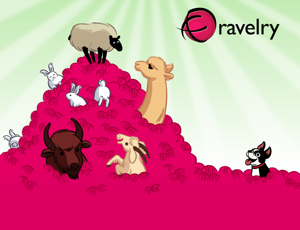 Ravelry is a social media platform with 8 million members of the knitting and crochet community. It’s a place for knitters, crocheters, designers, spinners, felters, and dyers to keep track of their yarn, tools, and patterns, and share ideas and inspiration.
Ravelry is a social media platform with 8 million members of the knitting and crochet community. It’s a place for knitters, crocheters, designers, spinners, felters, and dyers to keep track of their yarn, tools, and patterns, and share ideas and inspiration.
Knitting has always been a part of my life. Grandma Swenson knit me Barbie Doll outfits out of fine sock yarn. I learned to crochet from Grandma Kling. During college and graduate school, I knit through most of my lecture classes. My best friend from college, Amy E. Anderson, is a designer whose patterns for sweaters, hats, slippers, mittens, and bags I’ve knit and felted over the years. During several winters in the oughts, I taught knitting classes at the Finger Lakes Fiber Arts yarn shop in Watkins Glen, NY. I’ve taken dyeing classes and been a member of the Black Sheep Fiber Guild. I still spin. It is a form of meditation, a discipline. Craft for many, art for some.
 For pattern designers who author knitting books, Ravelry is a key platform in their business plan. It’s a quick way to find your target audience. It’s a marketplace of goods and services for the fiber arts and crafts community and free to the user. It’s not a place where you’d expect to find a lot of hate speech.
For pattern designers who author knitting books, Ravelry is a key platform in their business plan. It’s a quick way to find your target audience. It’s a marketplace of goods and services for the fiber arts and crafts community and free to the user. It’s not a place where you’d expect to find a lot of hate speech.
But on Sunday, June 23rd, Ravelry implemented a new policy. “Do Not Post In Support of Trump or his Administration.” They aren’t endorsing Democrats or banning Republicans. The incivility in online discourse made a new policy necessary.
Ravelry isn’t Goodreads either. The social media platform focused on books has experienced similar problems and authors find themselves targets of trolls and haters. Goodreads is owned by Amazon, and like Amazon Reviews, there is insufficient moderation of online content.
 That a social media platform focused on fiber arts would become so contaminated with politically polarizing language as to require a change in user policy suggests the toxic climate online is widespread regardless of the subject matter.
That a social media platform focused on fiber arts would become so contaminated with politically polarizing language as to require a change in user policy suggests the toxic climate online is widespread regardless of the subject matter.
This presents new challenges to an author today. When you publish a book, you want to be able to be found online and engage with your readers in constructive conversation. But you don’t want to be trolled by haters, stalked, or doxxed. So what is the right social media strategy for you and your book?
That depends entirely on you and your project. You need to consider what you prefer to keep private (phone numbers, home address, children’s photographs, etc.) and what you will make public about your author persona.
Begin gathering email addresses early and compile a list of those who opt-in to receive information from you about your forthcoming book. Email remains one of the most powerful social media methods for book sales. Opting-in to an email list can be easy with MailChimp and a sign-up button on your website.
 Email newsletters and/or blogging? If you are early in the process of preparing a manuscript/proposal, then blogging no more than once a week and no less than once a month can help you build your email list. Once you have a contract for publication, then you can send out an initial newsletter announcing your forthcoming publication. Then not again until 30 days before release for pre-orders with news of initial reviews and launch events.
Email newsletters and/or blogging? If you are early in the process of preparing a manuscript/proposal, then blogging no more than once a week and no less than once a month can help you build your email list. Once you have a contract for publication, then you can send out an initial newsletter announcing your forthcoming publication. Then not again until 30 days before release for pre-orders with news of initial reviews and launch events.
If you are well on your way to publication, then blogging and newsletters are less important than the manuscript. Blogging takes time away from writing, revising, editing the book. Books are long-form, and blogs are short. While you are writing your manuscript, it may be easier to ignore social media marketing and focus on the book. Too much promotion and publicity too early can undermine your efforts.
When you are on social media, be social. Be civil. I recommend authors spend less time on social media. It’s a huge time suck. Ten minutes a day. Limit your exposure.
If you are on social media, then reach up—instead of out—to increase your audience. Too often authors think it is the number of followers or fans and focus on increasing the numbers. Instead of quantity, focus on quality of your connections. Instead of following people who might or might not be interested in your book, follow those writers whose work you admire, editors or agents in your genre, leaders in your field. Follow the people you would reach up to for guidance and advice. You won’t make any more book sales from buying 100K Twitter followers. And you might read or see something interesting if you follow your professional interests on Twitter.
 Think of social media as research tools. Okay, surveillance weapons. If social media companies can use these platforms for surveillance of your behavior, you can use them for market research. Learn more about your audience. Think of social media less as a megaphone to promote your book and more as an earpiece to listen carefully. Think about where you want to plug in and contribute to the conversation.
Think of social media as research tools. Okay, surveillance weapons. If social media companies can use these platforms for surveillance of your behavior, you can use them for market research. Learn more about your audience. Think of social media less as a megaphone to promote your book and more as an earpiece to listen carefully. Think about where you want to plug in and contribute to the conversation.
Social media can extend relationships established in real time face-to-face. It can connect those who are already socially related. It’s not great at creating new relationships, and without any face-to-face contact, they are harder to maintain.
For too long, there has been an overemphasis on using Facebook, Twitter, Instagram, LinkedIn, and Pinterest in establishing an author platform. Social media is one item in your toolkit for building an audience platform for your book. More rewarding is getting short pieces published in the right places. Admission to the right juried workshops or acceptance of papers at conferences or bookstore readings of works-in-progress. Build your literary community.
 As the social media landscape becomes increasingly toxic in terms of political polarization, it’s best to keep both feet planted firmly in the real world. Expand your audience through face-to-face social and professional interactions. And carry your business card with an email address on it. Maybe take up knitting. It’s a year before the presidential elections, and there is now a Trump-free zone online.
As the social media landscape becomes increasingly toxic in terms of political polarization, it’s best to keep both feet planted firmly in the real world. Expand your audience through face-to-face social and professional interactions. And carry your business card with an email address on it. Maybe take up knitting. It’s a year before the presidential elections, and there is now a Trump-free zone online.

Wonderful advice. I Love it.
Wow, Jill! A fellow knitter AND a spinner. Bring your wheel up to the island, or better yet, take a spin on someone else’s. I’m sure someone will bring one.
I LOVE Ravelry (with big hearts and capital letters) and it saddens me that this space would be victim to inappropriate content.
Great tips on social media engagement!
Thanks for sharing the love of books AND fibers! I’m coming out to the island for a WRITING retreat…don’t tempt me to bring my wheel. Might bring you a little handspun yarn, though. Thanks for keeping it civil!
Bring the wheel, bring the wheel. I hear someone is thinking about bringing a LOOM. Oolala…